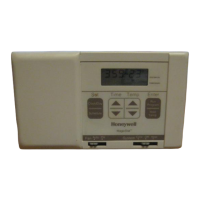
Do you have a question about the Honeywell CT2800A1009 and is the answer not in the manual?
| Product Type | Thermostat |
|---|---|
| Series | CT2800 |
| Model | CT2800A1009 |
| Type | Non-Programmable |
| Display | Digital |
| Accuracy | ±1°F (±0.5°C) |
| Temperature Range | 40°F to 90°F |
| Compatibility | Single Stage Heating and Cooling Systems |
| Power Source | Hardwired |
| Weight | 0.3 lbs |
Guidelines for proper disposal of old thermostats, especially those containing mercury.
Verify thermostat compatibility with your heating and cooling system using the provided chart.
Special instructions for disconnecting wires from C or C1 terminals on older clock thermostats.
Identifies incompatible systems with six or more wires and advises contacting customer assistance.
Guidance for three-wire heating-only systems, including isolation relay requirements.
Explains the 'bAt Lo' indicator and the importance of timely battery replacement.
Recommends replacing batteries annually to prevent system shutdowns due to power loss.
Defines the four daily programming periods: WAKE, LEAVE, RETURN, and SLEEP for weekdays.
Explains how to set separate schedules for weekdays and weekends, noting fewer periods on weekends.
Details the thermostat's behavior if no specific weekend program is set.
Advises using fingertips or soft erasers to press keys to avoid damaging the keypad.
States the thermostat's automatic heating and cooling temperatures if no custom program is set.
Guides setting time and temperature for WAKE, LEAVE, RETURN, and SLEEP periods on weekdays.
Guides setting time and temperature for WAKE and SLEEP periods on weekends.
Instructions for adjusting fan/system switches and starting the programmed schedule.
How to adjust the temperature for the current period only, which will cancel at the next scheduled change.
How to set and cancel a continuous temperature hold, overriding programmed schedules.
How to view the current temperature setting and cancel temporary changes or holds.
Method to cycle through and view the programmed time and temperature settings.
Steps to cancel a specific programmed time period.
How to permanently alter programmed settings by repeating the initial programming steps.
How to exit temporary changes or holds and resume the programmed schedule.
Explains the 'F' factory setting for the FUEL SWITCH and when to use the 'E' setting for electric heat systems.
Details how to adjust screws A and B on the thermostat back to optimize system on-time for different heating systems.
Specific instructions for adjusting screw A for high efficiency furnaces (90%+ AFUE).
Guidance on drilling pilot holes and using wall anchors for mounting the plate securely.
Instructions for positioning, securing, and leveling the mounting plate for optimal appearance.
Guidance on connecting wires from the wall to the correct terminals on the new thermostat.
Crucial step for 5-wire installations: removing the factory jumper between R and Rc terminals.
Instructions on securing wire connections and insulating the wall opening for draft prevention.
Steps to verify heating system functionality by adjusting temperature settings.
Steps to verify cooling system functionality, including compressor delay considerations.
Explains the 'AUTO' and 'ON' settings for the fan and their operational effects.
Details the 'COOL', 'OFF', and 'HEAT' settings for controlling the heating and cooling systems.
Steps to resolve issues where the thermostat display is blank.
Explanation for why temperature display may not go below 45°F or above 88°F.
Troubleshooting incorrect temperature changes due to programming or time errors.
Diagnosing and fixing problems where the heating system fails to activate.
Diagnosing and fixing problems where the cooling system fails to activate.
Troubleshooting temperature control issues, including checking settings and outdoor disconnect.
Resolving issues where the system is on but no heat is felt at registers.
Adjusting system on-time to correct frequent or infrequent furnace cycling.
Addressing discrepancies between thermostat display and actual temperature, and insulation of wall opening.
Contact information for Honeywell Customer Assistance, including required details before calling.
Details the product warranty, coverage, claim process, and limitations.